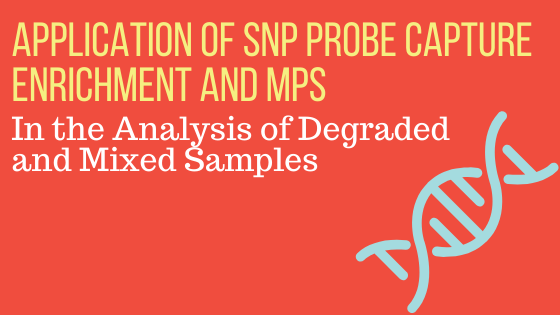Samples that are highly degraded and mixed in nature are commonly found in mass disaster events, missing persons, and forensic casework and often pose issues with conventional short tandem repeat (STR) typing by capillary electrophoresis (CE). DNA fragment sizes less than 150 bp present issues as two intact primer binding sites may not be present resulting in PCR amplification failure.
Written by: Jessica Lim, UC Davis
Mixture samples pose additional issues as current methods of STR analysis by CE are not sensitive enough to detect minor contributions below 10%. Mixture analysis by STRs are further complicated by stutter, allele drop-out and allele drop-in.
When samples are highly degraded and mixed in nature with multiple contributors, alternative markers and methods to STR typing by CE can provide additional information for identification purposes.
Single nucleotide polymorphisms (SNPs) have been proposed to be useful in the analysis of degraded samples due to their small genetic footprint, however the use of bi-allelic SNPs alone has lower discriminatory power when compared to STRs and limited capabilities in mixture detection and resolution due to their bi-allelic nature.
The use of additional types of SNP markers including tri-allelic/tetra-allelic SNPs, microhaplotypes, and haploid chromosomal (i.e. X and Y) SNPs have the potential to improve the mixture detection capabilities of SNPs, however multiplexing capabilities are limited with CE technology.
Next-generation sequencing (NGS) technology alleviates some of these challenges by providing greater multiplexing capabilities and sensitivity when compared to traditional CE technology. Additionally, NGS adds a quantitative component to mixture analysis due to the clonal amplification of DNA, allowing for bioinformatic read counting to estimate mixture ratios.
Amplicon-based methods are typically employed with next-generation sequencing, however PCR amplification failure can still occur with highly degraded samples due to the reliance on intact primer binding sites. Hybrid probe capture enrichment coupled with next-generation sequencing eliminates the need for intact primer binding sites by using multiple overlapping biotinylated probes to capture targeted regions of interest such as SNPs.
This study was part of my master’s thesis research in the University of California – Davis Forensic Science Graduate Program and the Children’s Hospital Oakland Research Institute (CHORI) in Dr. Cassandra Calloway’s lab, which focuses on the analysis of highly degraded and mixed samples utilizing mitochondrial DNA and single nucleotide polymorphisms (SNPs). The study was funded by NIJ Grant 2013-MU-MU-K044 awarded to Dr. Calloway.
The research was conducted under the supervision and mentorship of Dr.Cassandra Calloway, as well as scientific guidance from Dr. Henry Erlich at the Children’s Hospital Oakland Research Institute (CHORI).
We applied two versions of a custom SNP probe capture enrichment panel to two-person contrived mixtures targeting 25 ng – 1 ng of DNA with minor contributions ranging from 2.5%-50%. Mock-degraded mixtures targeting 25 ng of DNA and mechanically sheared to 150 bp were analyzed using a SNP probe capture enrichment panel for proof-of-concept. The SNP probe capture enrichment panel contains bi-allelic identity informative SNPs, haploid chromosomal SNPs, and multi-allelic markers, including tri-allelic/tetra-allelic SNPs and microhaplotypes, for mixture detection.
We examined the ability to detect the minor contributor in two person mixtures targeting 25 ng – 1 ng of DNA, as well as the estimation of the minor contribution using SNP probe capture enrichment and massively parallel sequencing. Additionally, we compared the performance of the SNP probe capture enrichment panel between mock-degraded and control mixtures to assess whether SNP probe capture enrichment can be applied to degraded mixture samples.
We found that SNP probe capture enrichment can be applied to mixture samples with detection of the minor contributor down to a 2.5% minor contribution in mixtures targeting as little as 1 ng of DNA. Additionally, mock-degraded mixtures captured with the custom SNP panel showed little difference in performance when compared to control mixtures.
Accurate estimations of the minor contributor were observed by bioinformatically counting reads in both control and mock-degraded mixtures due to the clonal method of sequencing using NGS technology and the high allele balance observed with both versions of the SNP probe capture enrichment panel. Future research should be aimed at improving the sensitivity of the assay as increased allelic dropout was observed with low input DNA mixtures as expected.
Our research demonstrates that the use of alternative markers, such as SNPs, and next-generation sequencing in the analysis of challenging samples, more specifically highly degraded and mixed samples, can be beneficial in cases where STR analysis by CE would typically fail.
Alternative enrichment methods to amplicon-based sequencing offer additional benefits as hybrid probe capture enrichment is not reliant on PCR primer binding sites, allowing for the application to samples that are highly degraded and mixed in nature, such as those found in mass disaster events and extreme environments.
By using next-generation sequencing, the detection and resolution of mixtures can be performed at the sequence level providing additional quantitative genetic information that can be helpful in mixture analysis.
WOULD YOU LIKE TO SEE MORE ARTICLES LIKE THIS? SUBSCRIBE TO THE ISHI BLOG BELOW!
SUBSCRIBE NOW!


